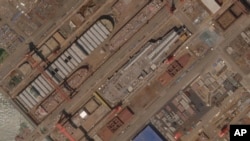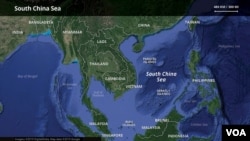China has launched a third aircraft carrier, likely a way to upgrade overall defenses in the face of stronger navies rather than to target any specific future battleground, analysts believe.
The carrier, called the Type 003 and christened Fujian, left its drydock at a shipyard outside Shanghai Friday morning and tied up at a nearby pier, state media reports said.
A third aircraft carrier would place China in a group of just 16 countries worldwide with the massive seaborne military airports. Around the Pacific, India, Japan and the United States operate carriers or are developing them.
China is after the same thing others are, experts say, which is proving to themselves and foreign governments that its carriers can someday work well together alongside older military units, if needed, as Western-backed rivals gain their own strength at sea.
The People’s Liberation Army Navy China received its first carrier, named the Liaoning, in 2012. It’s an overhauled former Soviet vessel bought from Ukraine. In December 2019, the navy got the Shandong, its second carrier and the first one built domestically.
“To develop aircraft carriers and enhance the ability to safeguard world peace is a necessary requirement for China to fulfill its international obligations,” said Liu Pengyu, spokesperson for the Chinese Embassy in Washington, D.C. “China is committed to the path of peaceful development and firmly pursues a national defense policy that is defensive in nature. The possession of aircraft carriers will never change that.”
Slow uptake
The latest Chinese carrier must train for another two to three years before making any formal deployments, analysts believe.
Huang Chung-ting, associate research fellow with the Institute for National Defense and Security Research in Taipei, suggested the Type 003 may have been rushed into production to satisfy Chinese officials and some of its parts might not work as designed or as well as peers from other countries.
“Whether China’s technology can reach its ideal capabilities, we need to monitor their training and sea trial results and see,” Huang said.
“I think these PLA’s aircraft carriers have no way to do long-term activities outside the first-island chain,” he added. “Their power is actually, for the most part, in the near seas inside the first-island chain.”
The first-island chain runs south from Japan through Taiwan and the Philippines to Indonesia. Japanese and U.S. forces have traditionally had more strength than China in the wider Pacific Ocean to the east. Japan has two carriers under construction and the U.S. Navy operates 11.
Type 003’s aircraft-carrying technology is energy consumptive and some of it might do poorly in a battle outside the first-island chain – far from Chinese ports — Huang said.
Eventually, Type 003 will put to use technology that’s better than many foreign peers, said Chen Yi-fan, assistant professor of diplomacy and international relations at Tamkang University in Taiwan.
He pointed to a “very advanced” domestically made electronic magnetic catapult. “It was jumping at least two generations ahead of other aircraft carriers,” he said.
But Type 003 would struggle outside the first-island chain for lack of bases where it could resupply, Chen said. The United States, in contrast, has bases in Hawaii, Guam and Japan.
Future battlefields?
Type 003 is expected to report back to Fujian province in China’s southeast near Taiwan, Chen said. The Liaoning and Shandong are assigned to other nearby seas, he added.
China has claimed self-ruled Taiwan as its territory since the Chinese civil war of the 1940s, when Chiang Kai-shek’s Nationalists lost to Mao Zedong’s Communists and rebased in Taipei. Beijing says it will use force, if needed, to unite the two sides. Since mid-2020, it has flown land-based military planes over part of Taiwan’s air defense identification zone almost daily.
The Shandong has done at least one exercise in the South China Sea, according to the Chinese state-monitored Global Times news website. The first carrier, Liaoning, is believed to cover the East China Sea.
Beijing claims about 90% of the 3.5 million-square-kilometer South China Sea as its own, clashing with the claims of Brunei, Malaysia, the Philippines, Vietnam and Taiwan.
Japan and the United States have urged China to leave the sea open for international use and both have voiced support for Taiwan. Washington periodically passes its own carriers near the island as a warning to Beijing.
PLA see their aircraft power as “weakening” now as Vietnam and the Philippines acquire missiles that could attack back, Huang said.
The Philippines was moving earlier this year to buy BrahMos anti-ship missiles from an Indian-Russian joint venture. Vietnam has expressed interest in the same missiles.
“I think it is very risky for the regional security in the future, when China can have like three aircraft carriers, not only the South China Sea, but also the East China Sea,” said Nguyen Thanh Trung, a faculty member at Fulbright University Vietnam in Ho Chi Minh City.












